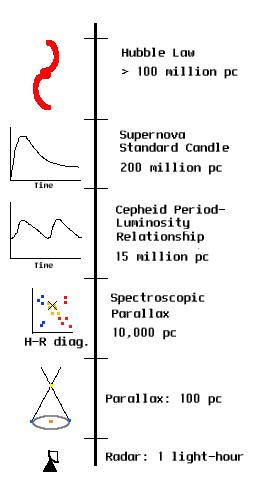
Summary
This exercise demonstrates three of the major distance measuring techniques: radar, parallax, and "standard candles" (both linear size and luminosity).What you need
A wristwatch or clock, paper, pencil, a rulerBackground and Theory
One of the most difficult problems in astronomy is determining the distances to objects in the sky. There are four basic methods of determining distances: radar, parallax, standard candles, and the Hubble Law. Each of these methods is most useful at certain distances, with radar being useful nearby, and the Hubble Law being useful at the most distant scales. Procedure Print out the worksheet.Part 1: Radar:
Using radar to measure the distance to an object is fairly straightforward, and much like using an echo. Dolphins find their way around underwater in this way, and you judge the sizes of large, dark rooms this way! We are going to simulate radar using a person for the pulse of light.
d=s·(t/2)
(This equation may be more familiar to you if worded this way: the distance traveled is equal to the speed times the time it took to get there. So if you are travelling at 60 mph for one hour, you've traveled 60 miles.)
In astronomy, a radio telescope is used for the radar dish (the Arecibo Radio Telescope, for example), the radar pulse travels at the speed of light (186,000 miles per second), and much larger distances are involved, such as the distance to Mercury.
Part 2: Parallax:
Part 3: Standard Candles:
Record your height and that of your lab partner in the chart on the worksheet.
Should it be?
There are a lot of sources for error in this portion of the lab. Name a few of them. To get you started, think about the assumptions that we are making about the streetlights. Which of these sources of error also apply in an astronomical context?